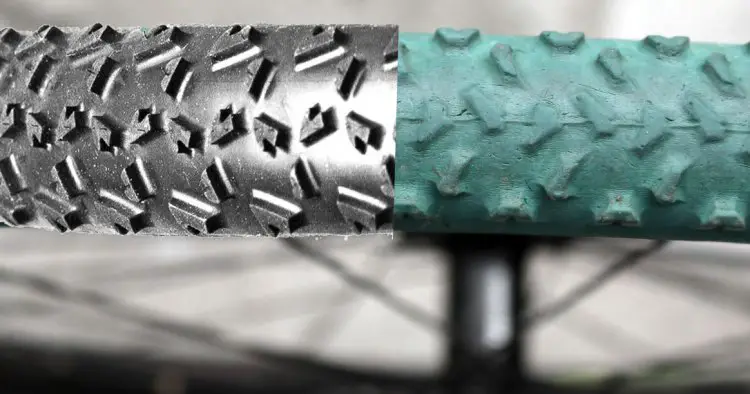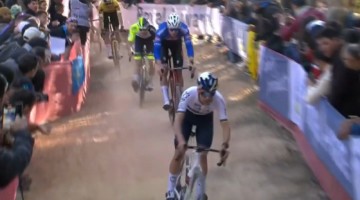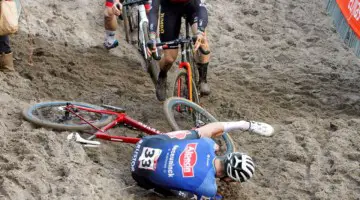As Wout van Aert rolled around the Cyclocross World Championship course, for the second time in three years, there were questions rolling in about his tires.
Details on Wout's tires, anyone????? #cxworlds #Bieles2017
— Amanda Nauman (@_amanda_panda_) January 29, 2017
We wrote about Van Aert’s green tires two years ago, but it’s worth revisiting the fascinating (for tire geeks at least) topic, especially now that it’s gotten more attention with his dramatic win on Sunday in Bieles, instead of silver behind Mathieu van der Poel in Tabor.
In the muddy, rocky, flat tire festival otherwise known as the 2017 Cyclocross World Championships, could Van Aert’s tire choice have made a difference? He flatted only once, while Van der Poel flatted four times, and other racers flatted even more times than that.
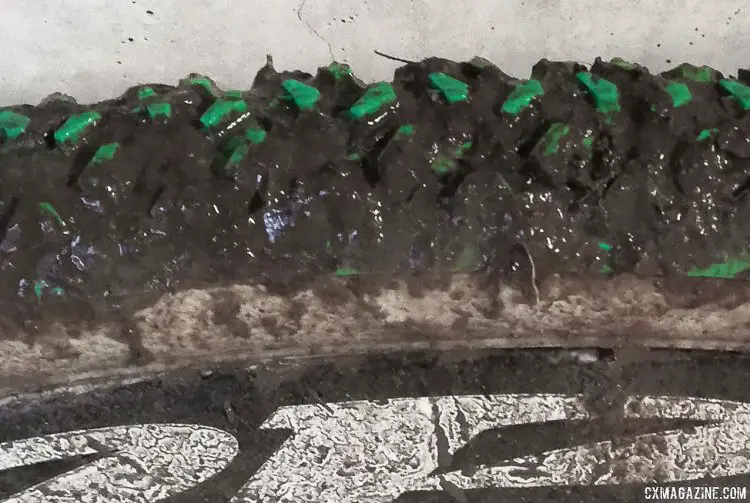
Wout van Aert’s green Michelin Mud treads on Dugast casings used to win the 2017 UCI Cyclocross World Championships. Bieles, Luxembourg. © Cyclocross Magazine
Coveting History, Planning Ahead
Van Aert surprised many back at the 2015 Cyclocross World Championships in Tabor by racing a pair of Neils Albert’s old original Michelin Mud treads glued to Dugast tubular casings. Michelin’s famous mint green tires haven’t been produced in almost 17 years, but the silica-based green rubber was touted to have good grip in wet conditions, and the tall knobs, generous volume and open tread made the tire a winner.
Albert had an old pair in his basement and outfitted one of Van Aert’s bikes with them back in 2015 for Worlds.
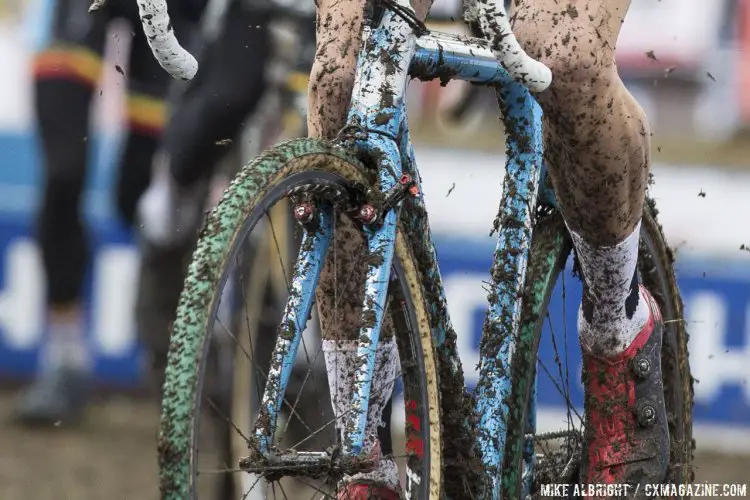
Wout van Aert raced Niels Albert’s old Michelin Mud-treaded Dugast tubulars at the 2015 Cyclocross World Championships. © Mike Albright / Cyclocross Magazine
Together with team manager (and former World Champion) Albert, Van Aert made the decision to race the 2017 Worlds in Bieles with the exact same tire configuration he used back in Tabor in similar mixed conditions.
Only this year, he had more than a single pair at his disposal. Albert planned ahead for these types of conditions and might have bidding up the prices for NOS green Michelin Muds on eBay. Back in November, Albert dropped six Mud clinchers off with Dugast’s Richard Nieuwhuis, and according to Sporza, picked them up as tubulars at the Hoogerheide World Cup (which Van Aert skipped due to his knee injury).
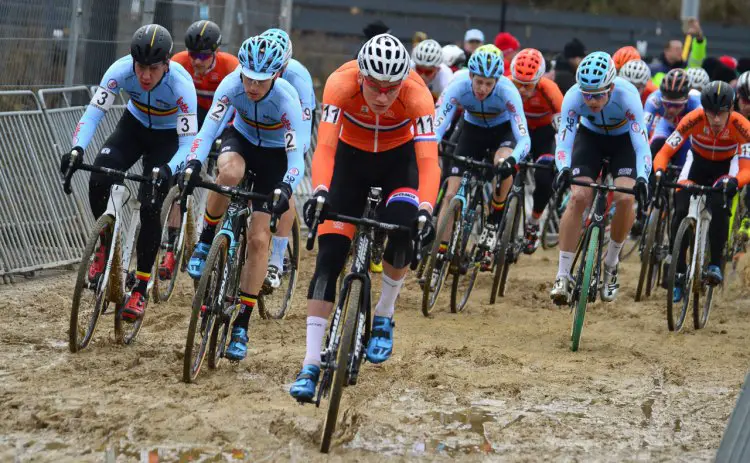
Wout van Aert wasn’t afraid to stray from convention, and his decision to roll on old Michelin Mud treads could have played a role in leaving others green with envy of his jersey. 2017 UCI Cyclocross World Championships, Bieles, Luxembourg. © C. Jobb / Cyclocross Magazine
“When I had [the tires] with me in Hoogerheide, everyone said we were crazy,” Nieuwhuis said.
The tread, when clean, made Van Aert easy to spot in Bieles, but when mud covered, understandably fooled the English video commentators into thinking he switched back to traditional black tubulars. But our eyes and pixel peeping indicate he stayed green the entire time, even after flatting one of the precious tires once.
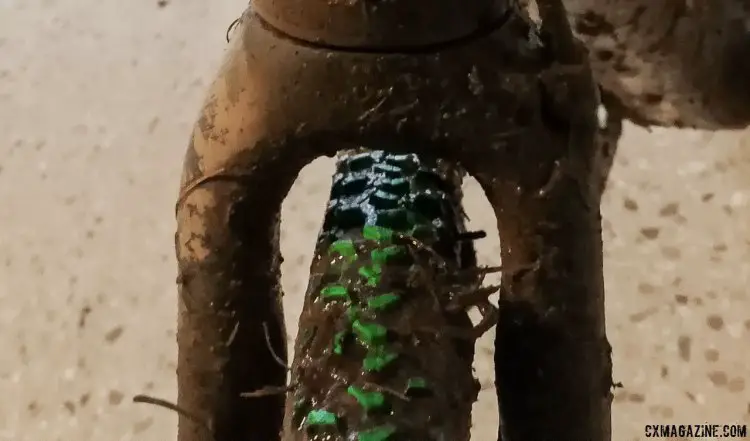
Wout van Aert’s green Michelin Mud treads still look relatively fresh – not dried out or crusty – on the Dugast casings used to win the 2017 UCI Cyclocross World Championships. Bieles, Luxembourg. © Cyclocross Magazine
The tires, even among clincher users, are a bit of a legend. Despite wearing quite quickly, the now-vintage Michelin Mud tires developed quite a following that’s survived 17 years after production has stopped. The green Mud clinchers even famously replaced Tim Johnson’s tubulars on some snowy, muddy days. The clinchers are still are coveted, and NOS tires can sometimes claim more than $100 per tire on eBay.
Can Going Green Pay Off?
Albert has a basement full of interesting tires, especially since he retired unexpectedly at the peak of his career.
Albert and Van Aert said after the race they opted for the ancient treads to protect against flats.
“The night before the race, I turned on the television and heard amazing stories about five, six flat tires during the races,” Van Aert said, reports Sporza. “At first it was very hard to believe this. It’s a pity that this tainted the World Championships, but we chose the good tires. I didn’t steal the World Championship title.”
Van Aert thought the green tread Dugasts would offer more protection. “Before the race I had the feeling that the green tires didn’t hit the rocks as much. It was definitely a boost to stand on the start line with them, we had something that the others didn’t think about.”
While before the race, Van Aert’s bike on display had traditional Dugast Rhino tubulars, hiding in the back was a Michelin Mud-dressed steed.
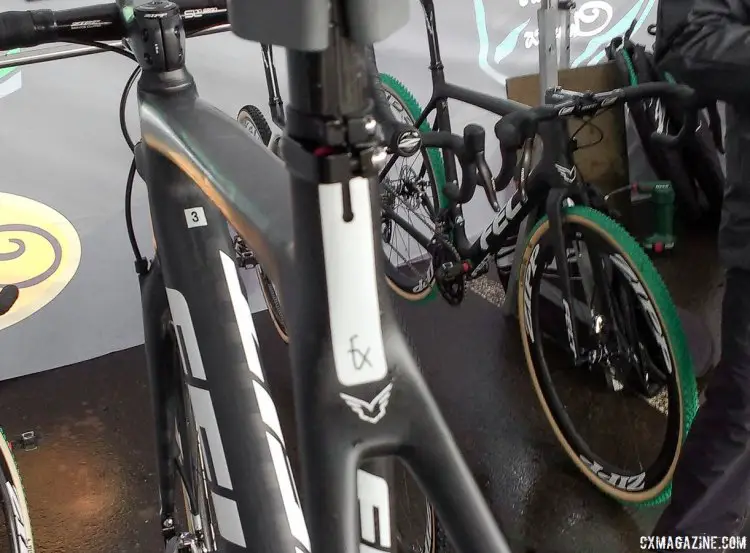
Wout van Aert’s bikes before the start, with the green Michelin Mud bike hiding in the back. 2017 UCI Cyclocross World Championships, Bieles, Luxembourg. © Cyclocross Magazine
“At first it was very hard to believe this. It’s a pity that [flats] tainted the World Championships, but we chose for the good tires. I didn’t steal the World Championship title.”
Perhaps it wasn’t just luck or a special tread that helped Van Aert avoid flats, but higher pressure to finish a pressure-cooker of a race.
Van Aert’s dad said from pits during the race, “We thought about the tire pressure and ran them a bit higher. He’ll have to take the technical zones slower but then there’s less chance of flat tires.”
Hidden Flat Protection or Luck?
Neither green Silica rubber nor a Michelin Mud tread pattern offer special flat protection based on our experience. The material, as mentioned, tended to be softer and faster wearing than a carbon black rubber. Softer (or lower durometer) rubbers, if protected from drying out and becoming brittle, typically are pierced easier by sharp objects.
Even the tread pattern of a Michelin Mud doesn’t appear to offer significantly more knobs than a Dugast Rhino or similar mud tread.
So what’s the advantage? When Van Aert claims “I had the feeling that the green tires didn’t hit the rocks as much” what he’s referring to is likely a factor of how his tires were constructed. By cutting out a nylon clincher tread that’s vulcanized to a 127tpi casing and then gluing them onto another tire casing in the form of Dugast tubular fabric, you essentially end up with a less-supple, more-reinforced layer underneath the tread compared to a standard Dugast Rhino.
It’s a compromise in order to ride a favorite tread pattern at the expense of suppleness. Against large, blunt objects, the sidewall of the tire still remains supple, but as demonstrated by our rudimentary CXM Labs suppleness tests in Issue 28 that tested clinchers, tubulars and tubeless setups, suppleness has so many factors beyond the suppleness of a sidewall, including rubber thickness, tread pattern, knob size.
Dugast tubulars already tend to be some of the lightest options for a given type of tread and volume, and that means the rubber layer has to be reduced in thickness for measurable weight savings over more robust offerings.
Replace that thin rubber layer of tread with a full tread and casing of a clincher and you’ve got a stiffer, more puncture protected tire.
It’s a theory that is relevant to gravel racing, where sharp rocks can be commonplace, and supported by both Maxxis and Challenge Tires representatives.
As to whether Van Aert’s dad saying that higher pressure helped avoid flats, it’s not clear if this is true. While Van Aert’s title-winning ride and “only” one flat don’t contradict his philosophy, the truth might depend on how many flats were caused by pinches (smashing the tire on a bigger object, catching the tube between the tire and the rim) or simple cuts and punctures by smaller rocks. Post-race chatter and interviews seem to indicate it was more of the latter.
It’s unclear as to whether higher pressure avoids tire cuts, and the tire companies don’t agree on this topic either. Lower pressure could expose more of the tire to sharp objects, but it could also give the tire a better chance to conform to the object. Ever try cutting or piercing a limp piece of fabric? It’s a lot harder than when it’s taut.
Of course, if you’ve ever seen an old Green Michelin Mud that’s been stored out in the open without climate and humidity control (or at least the protection of a sealed plastic bag) the tires get hard, stiff, and even start to crack. Hard, stiff rubber might avoid cuts better, but from our close look at Van Aert’s race-winning tires, the tread and rubber look to be in great condition.
Nieuwhuis thinks age has something to do with Van Aert avoiding more than one flat, saying tires made from materials older than six months are fully cured and stronger, but we’re talking about tires made a few months ago from treads made around 20 years ago.
It’s Not Easy Being Green
While cyclocross racers who have been around for a few decades might have an old worn-out pair buried in the garage, it’s not easy to mimic Van Aert’s tire choice on the day.
Albert says he also has more special tires in his basement, and maybe one day we’ll see more of them on racers’ bikes. We wouldn’t be surprised if they’re stored in a special tire cellar, similar to a wine connoisseur.
Albert isn’t the only one. Sven Nys pulled these tires out of his basement as well:
Te koop, tuben type Dugast Michelin. Goede staat, bouwjaar 1997. Ik doe ze weg wegens met pensioen. pic.twitter.com/vqnENBtB1D
— Sven Nys (@sven_nys) January 30, 2017
While Van der Poel may not have had the exact same tire choice options as Van Aert, he defended his choice to run what he always uses. “For me, the World Championships are a race like any other, I see no reason to consider other tires… it’s just unlucky that you just land on a rock,” Van der Poel said. “On another course there are also 100 rocks, but you don’t flat.”
Could tubeless have saved the day? While Saturday’s more-frozen conditions kept more of the rocks hidden, as Van Aert heard on TV, there were still plenty of flat tires in the women’s race, including by third-place Katerina Nash. Two North American women who escaped flat tires were Becca Fahringer and Mical Dyck. Fahringer rode IRC Serac Mud and CX tubeless tires mated to NoTubes Valor rims, while Dyck, the highest-placed North American Elite finisher at Worlds in Tabor while riding tubeless, rode converted Kenda Kwicker clinchers on her NoTubes rims in Bieles. Both vulcanized nylon clinchers survived the piercing rocks of Bieles (small sample size of course).
Lastly, there is the very real possibility that Van Aert’s single flat was just pure luck. Kerry Werner, riding Clement’s tubulars, flatted only once (while Tobin Ortenblad flatted Clement tires twice). Again, small sample size, but Werner didn’t have the old rigid green tread to protect him and still won the Team USA “least flats” title.
Go Green Without the Bidding War
While Niels Albert, Sven Nys and even CrossVegas promoter Brook Watts have owned Michelin Mud Dugasts, you don’t have to rely on bidding on ancient treads (perhaps from Italy, see below) or break into Albert’s or Nys’ basement to have an eye-catching green silica cyclocross tubular.
After @WoutvanAert victory should I auction those on @eBay? Or you need some @mathieuvdpoel? Anyway… amazing race guys… #bieles2017 pic.twitter.com/XkfE5U2BU3
— igortavella (@igortavella) January 29, 2017
FMB Tires, the small France-based handmade tubular tire company, already satiates the green, silica cyclocross tire coveters with a new green rubber that was unveiled two years ago, albeit without the “double casing” flat protection discussed above. FMB’s newest tread, the all-conditions Slalom, developed with Katie Compton, comes in the green silica rubber. It’s a color that will remind old-timers more of the old green Vittoria Mastercross and Tigre treads, rather than the Michelin Mud clinchers.
What’s so special about silica? Silica is nothing new to bike or automobile tires. It’s used prominently in bicycle tires from companies like Michelin and Continental, and even used in Michelin’s current black Mud 2 cyclocross tire made with Michelin’s Energy rubber.
We’ll never be able to conclusively verify if Van Aert’s tire choice played a role in avoiding flats, but we do know that racers simply need to have confidence in their tires on race day or in training, and on Sunday Van Aert’s unique choice worked out well.
It’s a rule that applies to racers of all ages and ability:
Stay tuned to our 2017 Cyclocross World Championships coverage on our Worlds page here for more photos, video interviews, bike profiles and continuing coverage from Bieles, Luxembourg.












